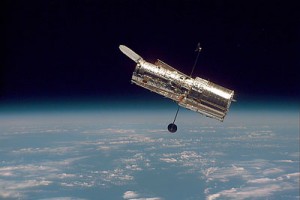Happy 25th Hubble!
 The Hubble Space Telescope (HST) was the first telescope to be placed in earth orbit. It is one of the more significant satellites in earth orbit and represents a technological leap in astronomy. The single advantage of earth orbit is that the HST is free from the distortion and interference of the earth’s atmosphere. This is a huge advantage and even today, 25 years after its initial operation. the Hubble is capable of observations far better than the newest and larger earth bound telescopes. The Hubble is capable of observations in a wide spectrum….from ultraviolet, through the visual spectrum, to infrared. It has a diameter of 95-inches, just over 2-meter, compared to earth telescopes much larger. tens of meters in diameter.
The Hubble Space Telescope (HST) was the first telescope to be placed in earth orbit. It is one of the more significant satellites in earth orbit and represents a technological leap in astronomy. The single advantage of earth orbit is that the HST is free from the distortion and interference of the earth’s atmosphere. This is a huge advantage and even today, 25 years after its initial operation. the Hubble is capable of observations far better than the newest and larger earth bound telescopes. The Hubble is capable of observations in a wide spectrum….from ultraviolet, through the visual spectrum, to infrared. It has a diameter of 95-inches, just over 2-meter, compared to earth telescopes much larger. tens of meters in diameter.
In 1993, shortly after it was placed in service, the Hubble made the first Deep-field observation and recorded images of galaxies further away than ever seen before….peering very deep into the night sky. The light from these galaxies began their journey over 1 billion years after the Big Bang, when the galaxies where very young. In 2002, the Hubble got an upgrade and was able to see further into the night sky….going back to just 700 million years after the Big Bang. In 2009, the last upgrade of the Hubble has allowed it to see even further…just 500 million years after the Big Bang. These incredible images will allow scientists to further refine their theories on how the universe was formed and the processes that occurred.
The Hubble Space Telescope is currently continuing to operate well but will continue to decline as equipment and systems deteriorate. After the last repair mission in 2009 the HST life was expected to be until at least 2013. It is now expected to operate as late as 2020. Because the orbit continues to decay and there is no viable way to boost its orbit, the HST will enter the atmosphere and be destroyed between 2030 and 2040. However, prior to its natural death it will most likely be guided to a controlled re-entry.
The successor to the Hubble is the James Webb Space Telescope (JWST) scheduled to launch in October 2018. The JWST is an infrared Telescope so that it can more efficiently see cooler and more distant objects.

